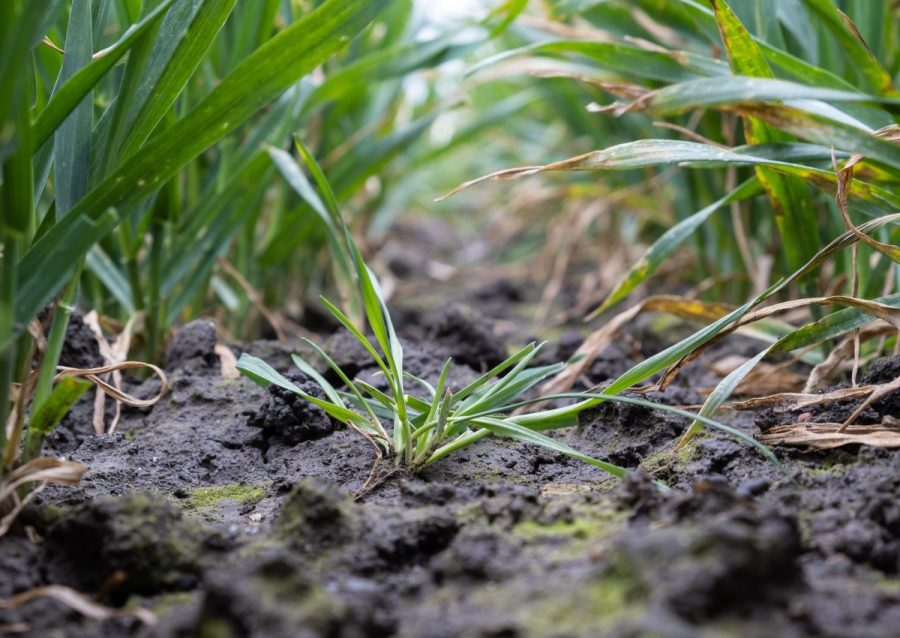Having mostly achieved a good level of weed control last season, experts are urging growers to avoid complacency and keep their foot on the gas as pre-emergence applications near. CPM opens up the discussion for this month’s Common Ground.
“If you have a historically bad grassweed area but a positive control year, you’ve had a good year but on a small proportion of the population.” JOHN CUSSANS
By Janine Adamson
In many instances, conditions last season proved conducive to effective grassweed control – whether that was from enforced later drilling, having adequate seedbed moisture, or, the results of a rotational plough reset.
While growers may have reaped the rewards of cleaner crops due to reduced weed pressure for a year, it mustn’t stop there, stress experts. In fact, the season should be perceived as a positive story to be replicated.
To discuss the topic further, CPM brings together weed scientist for ADAS, John Cussans; independent agronomist and former technical manager, Jeff Fieldsend; and BASF agronomy manager, Hugo Pryce.
Positive starting point
Opening the discussion, Hugo stated that having spoken to agronomists across the country, most seem content with the level of grassweed control achieved last season. “Drilling was quite convoluted with it turning wet, but fortunately the weather provided a break and there was another opportunity to drill.
“In the main, I think for the crop that’s being harvested now, grassweed control has been good.”
John added that last autumn’s wet conditions meant the power of a classic stale seedbed could really come to the fore. “Being forced away from drilling meant a much more elongated period of perfect conditions for weeds to chit, and that did lead to relatively low pressure in a lot of crops that were drilled.
“But we have to remember that the challenges on-farm are a lot more diverse now than simply just getting blackgrass control right. Due to changes in system approaches we’re seeing more varied weeds emerge such as bur-chervil or apera; plus an increase in ryegrass, brome and even wild oats.”
Having taken on two new farms last year, Jeff said he agreed. “The weather patterns actually played in our favour. When growers did manage to plant crops, there was plenty of moisture to make the most of the residual chemistry.
“That’s in addition to stale seedbeds, planting competitive varieties and where appropriate, using the plough as a targeted cultivation. While we’ll go back to min-till this year because we’ve achieved such a good result, we will rotationally plough in the future – perhaps one in three or one in four years – to keep on top of any issues.
“Ploughing is also a significant contributor to ergot control – which we saw a lot of in Harvest 2024 crops, in many cases because of the prevalence of grassweeds.”
Avoiding complacency
On the back of a successful year for grassweed control, Hugo stressed the importance of not being complacent. “It doesn’t take much, only single figures in terms of grassweed plants/m2, before you have an infestation. You can’t cure blackgrass in one year – that’s’ impossible.
“So it’s an ongoing process whereby you require 95% control just to stand still, otherwise you go backwards. And it all starts in the autumn, which is the most effective time to be controlling grassweeds given the efficacy of spring-applied contact chemistry is reduced in most cases.”
In response, John said he wanted to flip the conversation around to celebrate the year as an illustration of how effective an integrated weed management strategy can be.
“When you have the right drilling date for the field, have created an effective stale seedbed, and applied herbicides at the right time to get the maximum benefit, I think rather than taking that as it’s in the bank let’s move on, we have to learn from it.”
Jeff added that he has no intention of taking his foot off the gas and will continue with an integrated approach including using the best chemistry available. “Having seen the decline of herbicides such as flufenacet, we’re actually looking at incorporating actives into the programme such as tri-allate alongside Luximo (cinmethylin), to try and get the best result that we can.”
Understanding the seed-bank
Another reason to avoid complacency, stated John, is the fact that the emerged weeds in a field represent just 5% of the total present, with the rest waiting in the weed seed-bank. “Work sponsored by AHDB at their Strategic Farm East reinforces the principle that when control is classed as good, it’s actually 95% control of only 5% of the population.
“So if you have a historically bad grassweed area but a positive control year, you’ve had a good year but on a relatively small proportion of the population. That momentum of the seed-bank which has been built up over years should be in your thinking.”
Where the seeds physically are in the seed-bank should always be considered, continued John. “The AHDB project has looked at one field which has 95% of weed seed in the top 5cm, yet in another field only 10% is in the surface. This relates to cultivation strategy and how mixing the soil vertically interacts with the state of the seed-bank.
“You don’t necessarily have to dig many holes, rather consider what cultivation you’ve had in place during the past few years, and compare that with when you’ve had bad grassweed years and good grassweed years.”
In response, while highly knowledgeable about the threat of weeds, Hugo shared that he found these numbers staggering.
Maximising pre-em performance
Conversation in the group then evolved to the topic of herbicide performance and the importance of soil conditions including moisture. “I recall the autumn of 2022 when Luximo was launched, it was really dry in September and everyone was waiting for rain to give a chit of blackgrass, but it didn’t happen,” said Hugo.
“The clock ticked around to October and growers feared they wouldn’t have an opportunity to travel, so started drilling in into bone-dry seedbeds without having had a chit. This put huge pressure on the pre-emergent chemistry.
“Then come the middle of October, we had decent rain and therefore achieved the performance from the chemistry once there was moisture in the seedbed – it was like chalk and cheese.”
He added that a benefit of Luximo is its label flexibility.“You don’t have to apply it pre-em if the conditions aren’t right; you shouldn’t be drilling into dry seedbeds.”
Jeff agreed that grassweed control is variable when applying to very dry seedbeds. “I also remember the launch of Luximo that year and the comments that came back from on-farm were, it’s not bad, but is it any better than straight flufenacet?
“Clearly it is, having compared it like-for-like, with a substantial improvement in the overall level of control. But I’m hearing the same concerns now regarding drilling dates and opportunities to travel, so I encourage loading the best chemistry pre-em due to the risk of not achieving peri-em application.”
However, when it comes to soil conditions, all of the little things do add up, he continued. “If possible after drilling, getting a set of rolls across to ensure a good, fine, firm seedbed will help; cobbly seedbeds are no good.”
In reflection, John reinforced the overall importance of autumn weed control. “It’s not a trivial business to achieve grassweed control – you only have effective herbicides in that autumn window.
“Then once you’ve done that, you’re waiting until the summer to see what the results are. We can adopt strategies to help the transition of autumn weed control to the outcome in the summer, such as seeds rates, crop and variety choice, but even so, it can be unpredictable and disappointing in some seasons. When we have a good year, I don’t know why we don’t congratulate ourselves more, because it really is hard.”
Championing best practice
Furthermore, John stressed the importance of adhering to stewardship guidelines and best practice for not only Luximo, but all other crop protection products. “Hearing rumours of Luximo being used straight, or even multiple applications – this is absolutely not acceptable or responsible.
“We really can’t afford to impact the long-term sustainability of Luximo with short-term thinking because it’s arguably become a mainstay. Going forward, it’ll be even more important to the industry, and if we want to grow winter cereals, we have to look after it. We’re unlikely to get another active like Luximo for quite some time.”
Hugo agreed: “While it’s doing the heavy-lifting in weed control, it has to be mixed with other active ingredients to support and protect it. Equally, it’s critical to remember that for blackgrass and ryegrass, there’s only one rate and that’s its full rate which delivers 500g of active.”
Jeff added that an aspect important to him is water volume. “I tend to use 200-litres minimum; don’t cut water volumes, make sure forward speed is reduced and use appropriate, angled nozzles.
“When applying a product – one which is admittedly expensive – we have to use it in the best possible way. We’ve learnt from issues faced in the past regarding spraying at speed or in windy conditions – it just compromises the performance of the product.
“When growers are investing a lot of money on chemistry, it has to be done right using the best information that we have available.”
Any other business
As the discussion came to a close, Hugo highlighted that if ryegrass is the problem weed, as well applied in combination with another mode of action, Luximo should be used as part of a wider sequenced programme.
“A sequence is the way to go because with ryegrass flushing throughout the season, it extends that period of activity.”
Jeff then shared his plans for this coming autumn. “I’m looking to use Luximo as the base for my pre-em application because I’ve seen the results during the last two or three seasons when it’s performed well. We’ll also be adding competitive varieties to that,” he concluded.
This article was taken from the latest issue of CPM. Read the article in full here.
For more articles like this, subscribe here.
Sign up for Crop Production Magazine’s FREE e-newsletter here.




